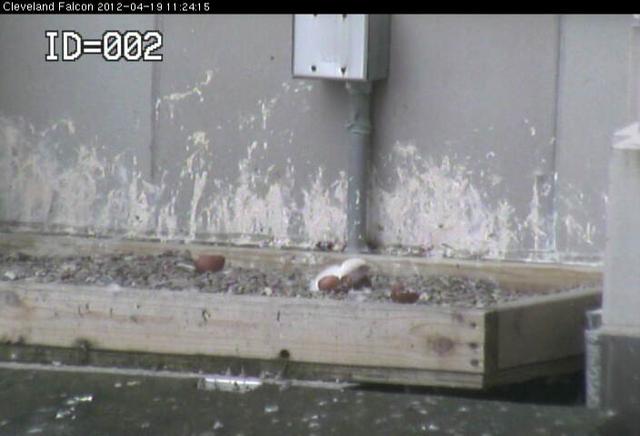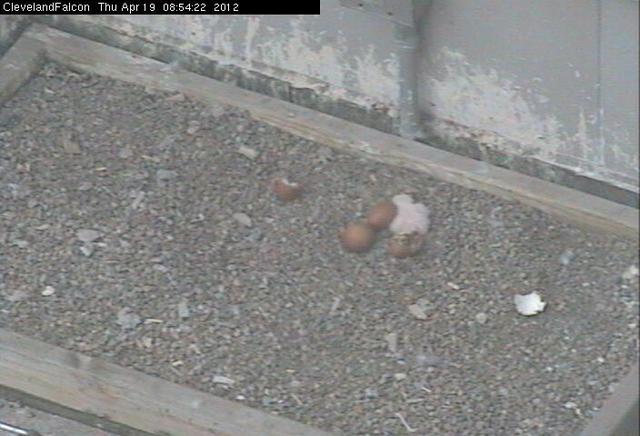FALCON FLASH
Dateline: Cleveland, Ohio
April 25, 2012
Click here to read what happened earlier
Volunteer nest monitor, Mr. Wright, tells us: "The chicks will spend a great deal of time sleeping and huddled together for warmth. What to look for..... You want to see each kid with two wings, two legs, two eyes and a beak, you also want to see the "begging response", any time a parent is near...... The parents will cover (mantle) the young for 4-7 days. The young are not able to control body temperature (self-regulate) for about a week, if it stays chilly”.
It's fun to record the date that each egg hatches and then record the eyass’s growth and progress. When does it have its first meal and what will that be? When will it take its first step? When will it get its first real feather? When will it fly? You can do this in a falcon journal, a technique that wildlife biologists use as they study the peregrines. To help you record the eyass's progress, you can go to the FalconCam and click on the archives link under each of the 3 current pictures to see all the day's activities.
Earth Day is Sunday, April 22, and watching the tiny falcon hatch during Earth Week reminds us of how fragile and how grand nature can be. The species peregrine falcon has recovered from near extinction in North America, and its comeback is one of the great success stories of wildlife conservation. Let's commit ourselves to the future of all species.
Will the remaining 2 eggs hatch? Watch closely at: http://www.falconcam-cmnh.org/news.php
Our thanks to the Cleveland Museum of Natural History for sponsoring the FalconCams and for the stills.
Photos are courtesy of volunteers Mr. and Mrs. Saladin. They may be used in any non-commercial publication, electronic or print, but please give photo credit.
Throughout her nesting history, SW has had 3-4 chicks (properly called “eyass”) hatch and grow up in the nest. This year, however, the hatching has been very different. As you know, the first egg began to hatch, but the little eyass inside was not strong enough to break through, and it did not survive. Falcon fans were happy to see the second egg hatch normally. An interesting note is that a day or so after the successful hatch, SW or Boomer somehow removed the first failed egg from the nest.
The tiny falcon, properly known as an “eyass”, began to break through its shell with a “pip” which is a hole in the egg. In the following file photo you can see a little beak enlarging the pip.
Mr. Harvey Webster, Director of Wildlife Resources at the Cleveland Museum of Natural History tells us more about the hatch: “During the time from pip to hatch, the remaining yolk sac is drawn into the abdominal cavity of the chick along with the blood that has been flowing through the shell membrane, carrying out critical exchange of oxygen and carbon dioxide through the pores of the shell. As the lungs take over the respiratory function and the yolk sac and blood is drawn back into the chick's body, the opening into the abdomen is closed. When this is complete the chick vigorously attacks the shell in effort to get out of the egg as quickly as possible. That is why there is a lag between pip and hatch, to allow for these developments to happen before hatching can take place”.
As falcon fans watched the FalconCam, they knew a hatch had taken place, even though SW hadn’t yet given them a peak at the eyass. How? There were broken eggshells.
Soon the eggshells will be gone because SW will eat them. They are a rich source of calcium that her body needs.
A female falcon does not like to leave her eggs while they are hatching, but SW has to take a quick break every now and then.
While she was gone, we got a look at the tiny eyass.
Click here to read what happened next





